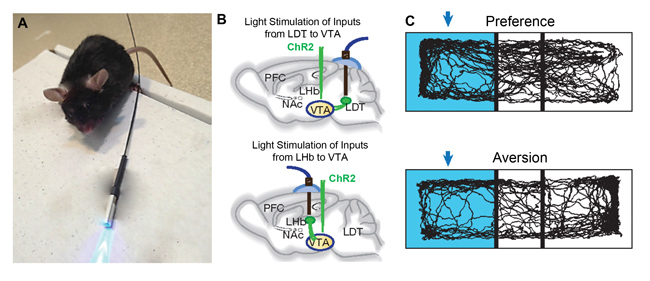MCB TRANSCRIPT

Mental Disorders: Identifying Brain Circuits Linked to Diseases
Conventional wisdom used to hold that one dopamine neuron — a type implicated in depression, schizophrenia and Parkinson’s disease — is much like another. But then MCB Assistant Professor Stephan Lammel showed that there are actually different types of dopamine neurons, a finding that could help us develop better treatments for neural diseases.

“Many drugs that are currently used to treat neural diseases target the dopamine system unselectively,” Lammel says. “The side effects can be so severe that some patients even stop their treatment.” Drugs for schizophrenia, for example, can cause side effects similar to Parkinson’s disease. Mental diseases are a leading cause of disability, and the World Health Organization estimates that one in four people will develop a disabling mental disorder during their lives.
Trained as a pharmacologist, Lammel saw many patients with neurological disorders, inspiring him to dig deeper into the causes. He began his investigation of dopamine neurons as a graduate student, discovering that there were different types in mouse brains. He found that dopamine neurons that projected to different parts of the brain also expressed different genes and proteins.
Lammel continued his work on dopamine neurons as a post-doc, studying their role in drug addiction as well as in behaviors associated with preference and aversion. To explore the brain circuits that underlie these behaviors, he used a new technique called optogenetics that controls brain activity with blue light. “We found that different brain circuits are necessary for eliciting reward-associated and aversion-associated behaviors in mice,” Lammel says.
This work opens the way for likewise exploring the brain circuits involved in psychological disorders, such as depression and addiction, which is key to developing better drugs for these diseases. “Many of the relatively indiscriminate drugs used to treat neuropsychiatric disorders have changed little over the last 40 years,” Lammel says. “This is largely because we do not yet understand how the neural circuits altered by these diseases operate in the healthy brain, let alone how they malfunction in disease.”
Using optogenetics and other new techniques, Lammel hopes to map and test the functions of brain circuits that involve different types of dopamine neurons. This could lead to new drugs that selectively target particular types of dopamine neurons, which could have the twin benefits of reducing side effects and treating psychological disorders more effectively than current drugs.

B. Optogenetic analysis of two circuits that involve dopamine neurons.
C. Activation of one circuit makes mice prefer one side of the chamber,
while activation of the other circuit makes mice avoid that side of the chamber.




